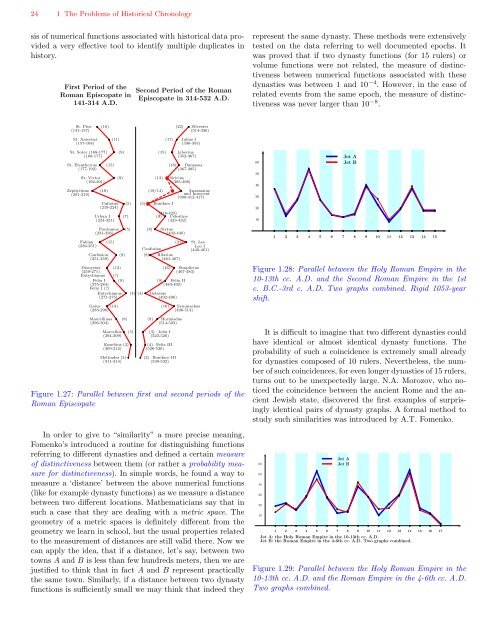mysteries of egyptian zodiacs - HiddenMysteries Information Central
mysteries of egyptian zodiacs - HiddenMysteries Information Central
mysteries of egyptian zodiacs - HiddenMysteries Information Central
Create successful ePaper yourself
Turn your PDF publications into a flip-book with our unique Google optimized e-Paper software.
24 1 The Problems <strong>of</strong> Historical Chronology<br />
sis <strong>of</strong> numerical functions associated with historical data provided<br />
a very effective tool to identify multiple duplicates in<br />
history.<br />
First Period <strong>of</strong> the<br />
Roman Episcopate in<br />
141-314 A.D.<br />
St. Pius (16)<br />
(141-157)<br />
St. Anicetus (11)<br />
(157-168)<br />
¤<br />
¤<br />
St. Soter (168-177) (9)<br />
(168-177)<br />
St. Eleutherius (15)<br />
(177-192)<br />
St. Victor (9)<br />
(192-201)<br />
Zephyrinus (18)<br />
(201-219)<br />
¤<br />
¤<br />
¤<br />
¤<br />
¤<br />
¤<br />
Calixtus (5)<br />
(219-224)<br />
Urban I (7)<br />
(224-321)<br />
Pontianus (5)<br />
(231-236)<br />
Fabian (15)<br />
(236-251)<br />
Confusion (8)<br />
(251-259)<br />
¤<br />
Dionysius (12)<br />
(259-271)<br />
Eutychianus (?)<br />
Felix I (9) ¤<br />
(275-284)<br />
Felix I (?)<br />
Eutychianus (4)<br />
(271-275)<br />
Gaius (13)<br />
(283-296)<br />
Marcellinus (8)<br />
(296-304)<br />
¤<br />
Marcellus (5)<br />
(304-309)<br />
Eusebius (3)<br />
(309-312)<br />
Meltiades (3)<br />
(311-314)<br />
¤<br />
¤<br />
¤<br />
¤<br />
¤<br />
¤<br />
¤<br />
¤<br />
Second Period <strong>of</strong> the Roman<br />
Episcopate in 314-532 A.D.<br />
¤<br />
¤<br />
¤<br />
¥ ¤<br />
¤<br />
¤<br />
¤<br />
¤<br />
¤<br />
¤<br />
¤<br />
¤<br />
¤<br />
¤<br />
(22) Silvester<br />
(314-336)<br />
(17) Julius I<br />
(336-353)<br />
(15) Liberius<br />
(352-367)<br />
(18) Damasus<br />
(367-385)<br />
(13) Siricius<br />
(385-398)<br />
¤<br />
(19/14) Anastasius<br />
and Innocent<br />
(398-412-417)<br />
¥ ¤<br />
¥<br />
(5) Boniface I<br />
(418-423)<br />
(9) Celestine<br />
(423-432)<br />
(8) Sixtus<br />
(432-440)<br />
¤ (21) St. Leo<br />
Confusion<br />
Leo I<br />
(440-461)<br />
(8) Hilarius<br />
(461-467)<br />
¤<br />
(16) Simplicius<br />
(467-483)<br />
(9) Felix II<br />
(483-492)<br />
(4) Gelasius<br />
(492-496)<br />
(16) Symmachus<br />
(498-514)<br />
(9) Hormisdas<br />
(514-523)<br />
(3) John I<br />
(523-526)<br />
(4) Felix III<br />
(526-530)<br />
(2) Boniface III<br />
(530-532)<br />
Figure 1.27: Parallel between first and second periods <strong>of</strong> the<br />
Roman Episcopate<br />
In order to give to “similarity” a more precise meaning,<br />
Fomenko’s introduced a routine for distinguishing functions<br />
referring to different dynasties and defined a certain measure<br />
<strong>of</strong> distinctiveness between them (or rather a probability measure<br />
for distinctiveness). In simple words, he found a way to<br />
measure a ‘distance’ between the above numerical functions<br />
(like for example dynasty functions) as we measure a distance<br />
between two different locations. Mathematicians say that in<br />
such a case that they are dealing with a metric space. The<br />
geometry <strong>of</strong> a metric spaces is definitely different from the<br />
geometry we learn in school, but the usual properties related<br />
to the measurement <strong>of</strong> distances are still valid there. Now we<br />
can apply the idea, that if a distance, let’s say, between two<br />
towns A and B is less than few hundreds meters, then we are<br />
justified to think that in fact A and B represent practically<br />
the same town. Similarly, if a distance between two dynasty<br />
functions is sufficiently small we may think that indeed they<br />
¤<br />
represent the same dynasty. These methods were extensively<br />
tested on the data referring to well documented epochs. It<br />
was proved that if two dynasty functions (for 15 rulers) or<br />
volume functions were not related, the measure <strong>of</strong> distinctiveness<br />
between numerical functions associated with these<br />
dynasties was between 1 and 10 −4 . However, in the case <strong>of</strong><br />
related events from the same epoch, the measure <strong>of</strong> distinctiveness<br />
was never larger than 10 −8 .<br />
60<br />
50<br />
40<br />
30<br />
20<br />
10<br />
<br />
<br />
<br />
<br />
<br />
Jet A<br />
Jet B<br />
<br />
¦§¦¨¦§¦¨¦§¦§¦©¦§¦¨¦©¦©¦§¦©¦§¦<br />
1 2 3 4 5 6 7 8 9 10 11 12 13 14 15<br />
<br />
<br />
<br />
<br />
<br />
© ©<br />
Figure 1.28: Parallel between the Holy Roman Empire in the<br />
10-13th cc. A.D. and the Second Roman Empire in the 1st<br />
c. B.C.-3rd c. A.D. Two graphs combined. Rigid 1053-year<br />
shift.<br />
It is difficult to imagine that two different dynasties could<br />
have identical or almost identical dynasty functions. The<br />
probability <strong>of</strong> such a coincidence is extremely small already<br />
for dynasties composed <strong>of</strong> 10 rulers. Nevertheless, the number<br />
<strong>of</strong> such coincidences, for even longer dynasties <strong>of</strong> 15 rulers,<br />
turns out to be unexpectedly large. N.A. Morozov, who noticed<br />
the coincidence between the ancient Rome and the ancient<br />
Jewish state, discovered the first examples <strong>of</strong> surprisingly<br />
identical pairs <strong>of</strong> dynasty graphs. A formal method to<br />
study such similarities was introduced by A.T. Fomenko.<br />
60<br />
50<br />
40<br />
30<br />
20<br />
10<br />
<br />
<br />
<br />
<br />
<br />
<br />
Jet A<br />
Jet B<br />
<br />
<br />
<br />
<br />
<br />
<br />
<br />
<br />
1 2 3 4 5 6 7 8 9 10 11 12 13 14 15 16 17<br />
Jet A: the Holy Roman Empire in the 10-13th cc. A.D.<br />
Jet B: the Roman Empire in the 4-6th cc. A.D. Two graphs combined.<br />
Figure 1.29: Parallel between the Holy Roman Empire in the<br />
10-13th cc. A.D. and the Roman Empire in the 4-6th cc. A.D.<br />
Two graphs combined.



